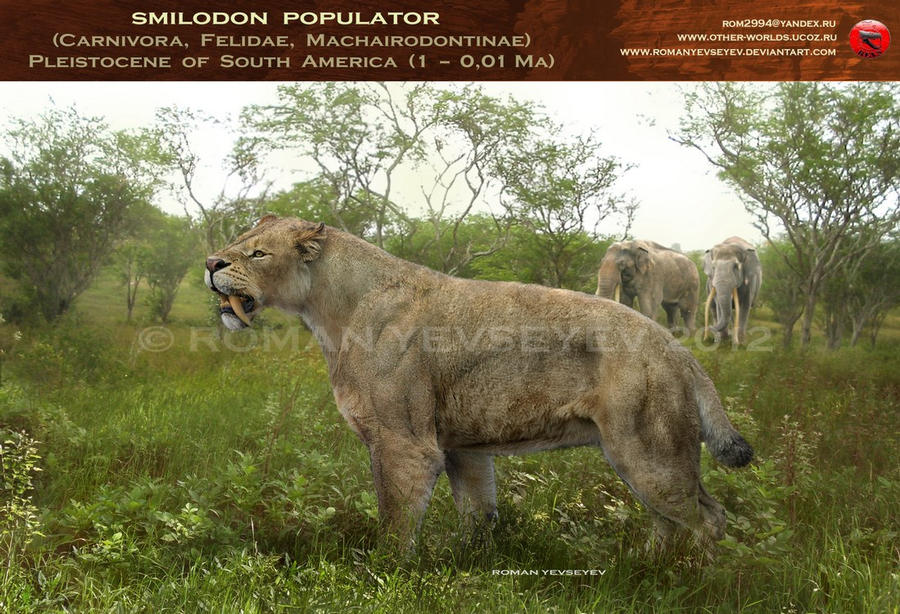Post by rock on May 13, 2019 7:28:03 GMT 5
Smiloson populator
Smilodon, often called a saber-toothed cat or wrongly a saber-toothed tiger, is an extinct genus of machairodonts. This saber-toothed cat was endemic to North America and South America, living from near the beginning through the very end of the Pleistocene epoch (2.5 mya—10,000 years ago). Smilodon populator ("Smilodon the Devastator"), 1 million-10,000 years ago; occurred in the eastern parts of South America and was the largest species of all machairodonts. It was much larger than its cousins, S. fatalis and S. gracilis, possessing a massive chest and front legs, and is the largest known variety of saber-toothed cat. It was more than 1.40 m (55 in) high at the shoulder, 2.6 m (100 in) long on average and had a 30 cm (12 in) tail. Smilodon populator was substantially heavier and larger than any extant felid, with a body mass range of 220–360 kg. Particularly large specimens of S. populator almost certainly exceeded 400 kg in body mass. Its upper canines reached 30 cm (12 in) and protruded up to 17 cm (6.7 in) out of the upper jaw. Genetic evidence suggests that Smilodon populator and other members of the genus diverged from the main lineage of modern cats (subfamily Felinae) around 14-18 million years ago.

Polar Bear-Ursus maritimus
The polar bear (Ursus maritimus), a bear native to the Arctic, is the apex predator within its range. Its thick blubber and fur insulate it against the cold. Its fur is hollow and translucent but usually appears as white or cream coloured, thus providing the animal with effective camouflage. Its skin is actually black in color, however. The bear has a short tail and small ears that help reduce heat loss, as well as a relatively small head and long, tapered body to streamline it for swimming. The polar bear is a semi-aquatic marine mammal that depends mainly upon the pack ice and the marine food web for survival. It has adapted for life on a combination of land, sea, and ice. Scientists and climatologists believe that the projected decreases in the polar sea ice due to global warming will have a significant negative impact on of this species within this century. The polar bear (Ursus maritimus) is the largest species of all bears and is the largest terrestrial carnivore on earth. Fully grown male polar bears range from 7' to 11' when standing upright, and weigh from 660 to 1,320 pounds. Females stand from 6' to 8' and weigh anywhere from 400 to 700 pounds. The largest polar bear on record was over 12' and weighed 2,210 pounds.

Credit to Wikipedia
Smilodon, often called a saber-toothed cat or wrongly a saber-toothed tiger, is an extinct genus of machairodonts. This saber-toothed cat was endemic to North America and South America, living from near the beginning through the very end of the Pleistocene epoch (2.5 mya—10,000 years ago). Smilodon populator ("Smilodon the Devastator"), 1 million-10,000 years ago; occurred in the eastern parts of South America and was the largest species of all machairodonts. It was much larger than its cousins, S. fatalis and S. gracilis, possessing a massive chest and front legs, and is the largest known variety of saber-toothed cat. It was more than 1.40 m (55 in) high at the shoulder, 2.6 m (100 in) long on average and had a 30 cm (12 in) tail. Smilodon populator was substantially heavier and larger than any extant felid, with a body mass range of 220–360 kg. Particularly large specimens of S. populator almost certainly exceeded 400 kg in body mass. Its upper canines reached 30 cm (12 in) and protruded up to 17 cm (6.7 in) out of the upper jaw. Genetic evidence suggests that Smilodon populator and other members of the genus diverged from the main lineage of modern cats (subfamily Felinae) around 14-18 million years ago.

Polar Bear-Ursus maritimus
The polar bear (Ursus maritimus), a bear native to the Arctic, is the apex predator within its range. Its thick blubber and fur insulate it against the cold. Its fur is hollow and translucent but usually appears as white or cream coloured, thus providing the animal with effective camouflage. Its skin is actually black in color, however. The bear has a short tail and small ears that help reduce heat loss, as well as a relatively small head and long, tapered body to streamline it for swimming. The polar bear is a semi-aquatic marine mammal that depends mainly upon the pack ice and the marine food web for survival. It has adapted for life on a combination of land, sea, and ice. Scientists and climatologists believe that the projected decreases in the polar sea ice due to global warming will have a significant negative impact on of this species within this century. The polar bear (Ursus maritimus) is the largest species of all bears and is the largest terrestrial carnivore on earth. Fully grown male polar bears range from 7' to 11' when standing upright, and weigh from 660 to 1,320 pounds. Females stand from 6' to 8' and weigh anywhere from 400 to 700 pounds. The largest polar bear on record was over 12' and weighed 2,210 pounds.

Credit to Wikipedia




